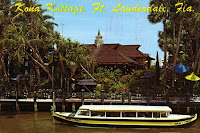 |
| Bahia Mar circa 1960s, Florida State Archives/Florida Memory |
801 Seabreeze Boulevard
Fort Lauderdale, FL 33316
By Jane Feehan
The following about Bahia Mar does not serve as an historical account of the business transactions that have shaped it over the years, though some will be mentioned. In 1949, the Miami News claimed Bahia Mar was the only land in Broward County that had not been privately owned; that may explain its complicated history.
Some would say its history began in the 1870s.
The United States government built a string of five Houses of Refuge in 1876 in Florida from Cape Florida to the Indian River to provide shelter for the shipwrecked. One refuge, New River House No. 4 was moved in 1891 from its first site near Hugh Birch State Park (Bonnet House) to the beach across from today’s Bahia Mar where the third Fort Lauderdale was built.
The United States Coast Guard operated from the site, a gathering place for social activities into the early 1900s. It served as Coast Guard Station No. 6 during World War I. From the inland waterway—today’s Bahia Mar—the base played an active role in World War II defense activities in South Florida.
 |
| Bahia Mar 1951 Florida State Archives/ Florida Memory |
Not long after opening, the developers declared bankruptcy and the site reverted to the city. The city leased it back to the private sector in 1959 (yes, it’s complicated). Since 1959, Bahia Mar has served as home to the Fort Lauderdale International Boat Show featuring some of the most spectacular luxury yachts seen anywhere.
Bahia Mar now faces a major transition. Value of the 38.65-acre Bahia Mar property is estimated (in 2022) at $256 million as Fort Lauderdale oceanfront land has fallen piece by piece to developers. The city signed an initial 50-year lease in 2022 with Jimmy and Kenny Tate of Rahn Bahia Mar Hotel. It could be extended another 50 years (status of this arrangement unclear).Their $1 billion plan for Bahia Mar includes, at this point, replacing the current 296-room hotel with a new one and building condos and commercial space. Developers plan to share revenue with the city derived from operations (hotel, marina, condos).
Resident support is mixed. Some fear the project’s impact on beach traffic and its impact on the boat show; others welcome the needed revamp. Stay tuned …
 |
| Bahia Mar 1968 Florida State Archives/ Florida Memory |
Sources:
Weidling, Philip and Burghard,
August. Checkered Sunshine. Gainesville: University of Florida Press, 1966.
Gillis, Susan. Fort Lauderdale: The Venice of America. Charleston: Acadia Publishing, 2004.
Fort Lauderdale News, March 7,
1949
Miami News, Sept 1, 1949
Fort Lauderdale News, Dec. 3, 1949
Fort Lauderdale News, April 10, 1955
New York Daily News, Jan. 27, 1957
New York Daily News, June 15, 1958
Sun-Sentinel, March 30, 2022
Real Deal, April 6, 2022
https://www.marinalife.com/marina?slug=bahia-mar-resort-and-yachting-center
https://bahiamaryachtingcenter.com/?utm_source=gmb&utm_medium=yext
https://janeshistorynook.blogspot.com/2014/03/houses-of-refuge-fort-lauderdale-and.html
For more on Houses of Refuge, see:
https://janeshistorynook.blogspot.com/2014/03/houses-of-refuge-fort-lauderdale-and.html
For more on William E. Schantz*
see:
https://janeshistorynook.blogspot.com/2021/06/bahia-mar-yacht-basin-cabbage-palm-logs.html
Tags: Bahia Mar Marina, Fort Lauderdale in the 1940s, Fort Lauderdale in the 1950s, yachting capital of the world. Fort Lauderdale International Boat Show, Fort Lauderdale history


































